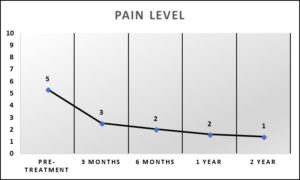Our Surgical Results – Patient Outcomes
Understanding shoulder surgery recovery time through real patient data. Dr. Gobezie tracks every patient's progress to deliver measurable, superior outcomes.
Dr. Gobezie is passionate about monitoring his patients' outcomes following surgery. Before surgery, we ask our patients to complete a questionnaire about their shoulder. With their consent, we track each patient's progress at certain intervals after surgery.
The data we gather from this feedback provides a concrete way to measure our patients' outcomes and understand realistic shoulder surgery recovery time expectations. Dr. Gobezie's practice is unique in that he has a research department studying these results to continuously improve patient care.

Studying Our Patients' Progress After Surgery
We aim to track all of our patients who are undergoing surgery, enabling us to provide accurate shoulder surgery recovery time estimates based on real data. This includes procedures such as:
- Biceps Tenodesis
- Reverse Shoulder Arthroplasty
- Total Shoulder Arthroplasty
- Rotator Cuff Repairs (RCR)
By tracking shoulder surgery recovery time across hundreds of patients each year, we can provide evidence-based expectations for your return to normal activities.
What Do Our Results Tell Us?
The data we have collected from our patients shows superior results as compared to the national average. Patients report lower levels of pain and a quicker shoulder surgery recovery time with faster return to mobility and function. This is in comparison to patient reports from other medical practices using the same outcome reporting database.
The key data points Dr. Gobezie collects from this research enable him to communicate to both patients and payors (insurance companies) about the quality of the care delivered. High volume surgeons are better able to provide value-based care, that equates to better outcomes over cost.
Per Year
Per Year
Surgeon Volume
Than Average
Dr. Gobezie is not only a top performing surgeon in Ohio but also one of the most experienced and efficient in the country. Each year, he performs more than 400 shoulder replacements and more than 600 arthroscopic shoulder procedures. In comparison, most general orthopedic surgeons typically perform around 20 shoulder surgeries in a year. Many published studies have indicated that the more times a surgeon performs a surgery, the better the patient outcomes and shorter the shoulder surgery recovery time.
Shoulder Surgery Recovery Time by Procedure
Click on the name of the surgery below for more information and patient outcome data, including detailed shoulder surgery recovery time expectations:
Biceps Tenodesis
Surgical reattachment of the biceps tendon to relieve pain and restore arm function. View recovery timeline and outcomes data.
View OutcomesTotal Shoulder Arthroplasty
Complete shoulder joint replacement for arthritis and severe joint damage. See patient-reported recovery milestones.
View OutcomesReverse Shoulder Arthroplasty
Specialized replacement for rotator cuff arthropathy and complex shoulder conditions. Review recovery expectations.
View OutcomesRotator Cuff Repairs (RCR)
Arthroscopic repair of torn rotator cuff tendons. Explore recovery data and return-to-activity timelines.
View OutcomesUnderstanding Your Shoulder Surgery Recovery Time
All graphs show marked improvement in pain and function in the first 3 months after surgery. These outcomes continue to improve through one and two-years post-surgery. Understanding shoulder surgery recovery time helps patients set realistic expectations and plan for their return to daily activities.
Pain Improvement Over Time

Pain scores indicate the patients' level of pain from pre-surgery to two years after surgery. Our data shows significant pain reduction within the first 3 months, with continued improvement through the full shoulder surgery recovery time period.
What We Measure
SANE Score
The SANE score represents how a patient rates their shoulder as a percentage of normal, 0% to 100% with 100% being normal. This helps track shoulder surgery recovery time progress.
ASES Score
The ASES score is a standard shoulder assessment that measures pain and functional limitations of daily activities on a 100-point scale. A maximum ASES score of 100 indicates minimal shoulder pain and maximal shoulder function.
Pain Score
Pain scores indicate the patient's level of pain from pre-surgery to two years after surgery, helping us monitor shoulder surgery recovery time and pain management effectiveness.
Why Surgeon Volume Matters for Recovery
Research consistently shows that high-volume surgeons achieve better patient outcomes and shorter shoulder surgery recovery time. Dr. Gobezie's experience with over 1,000 shoulder procedures annually translates to refined surgical technique, fewer complications, faster recovery, and better value-based care. When choosing a shoulder surgeon, consider their annual procedure volume as a key indicator of expected outcomes.
Learn About Your Shoulder Surgery Recovery Time
Schedule a consultation with Dr. Gobezie to discuss your condition, treatment options, and expected recovery timeline based on real patient outcome data.
Schedule Consultation